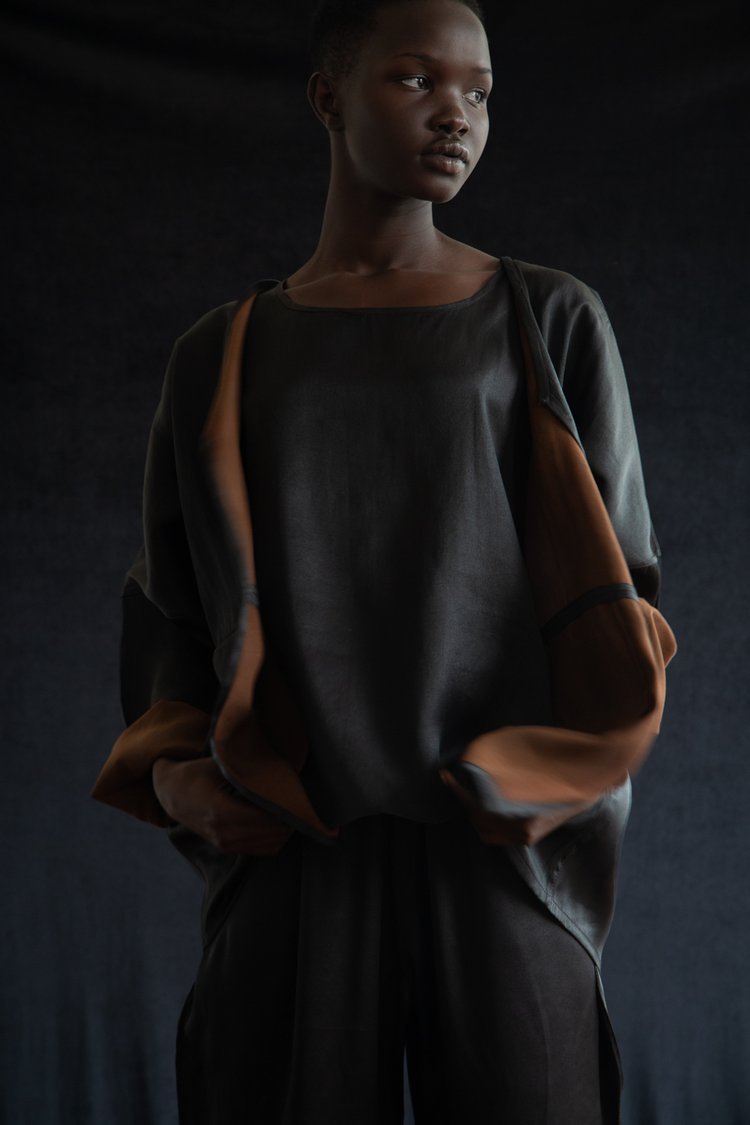Noir Mud Silk
Photo courtesy of Marcella Echavarria
Noir Mud Silk is a limited-edition womenswear collection made exclusively from traditional Chinese mud silk.
The seasonless, special edition collection is created in limited quantities based on this unique materials availability.
Produced in the Guangdong region, mud silk is characterised by a two-tone double-faced surface.
One side is soft, matt and rich in earth tones, while the other is glazed with a deep, dark, sometimes cracked glossy surface.
Marcella Echavarria’s first introduction to mud silk was in a Beijing restaurant, where a fellow guest swished by her table wearing a pair of mud silk pants which flowed like water over her legs, while emitting a tantalising rustle.
Mud silk goes by many names, each one reflecting the poetic nature of the material, tea silk, fragrant cloud silk, bamboo silk, soft gold singing silk cloth and lacquered silk, a reflection of the glossy ebony hue of the fabrics face, made with the mud from the Pearl River Delta.
The discovery of the process is attributed to local fishermen who used yams to make their fishing nets stronger, and to prevent rotting, which turned their nets black when exposed to the iron-rich mud of the Pearl River Delta.
The combination of yams and river mud lead to their use as a dye stuff for the production of mud silk.
The complex and time-consuming process to make mud silk begins by grinding and simmering a locally grown yam called Dioscorea cirrhosa with lengths of hand-woven silk, resulting in the iconic rich copper tonality of the reverse side of the fabric.
Once dyed, the fabric lengths are spread out on the grass to dry in the summer sun, a process that can only take place between the months of May and October due to the dependence on clement weather.
Once the silk is dry, it is coated with a layer of mud, swept on by artisans who spread it across the entire length of the top face of the fabric. The ferrous sulphate in the river mud creates a chemical reaction when it comes in contact with the vegetable tannin of the yams. The fabric is then rinsed in the Pearl River Delta only to be laid out to dry and be coated again in mud. This process is repeated between thirty and forty-five times, dependent upon the desired depth of colour, with the entire process taking months to complete.
Production is dictated by the seasonal cycle of nature’s rhythm, and at the mercy of the climate, thereby limiting production to the summer months.
The finished fabric is light, soft, crisp, and has antibacterial and antiviral properties as a result of the tannins in the yam.
The process to make this heritage rich textile has remained unchanged for 2,500 years, and the Ming Dynasty in the fifth century....
The process to make this heritage rich textile has remained unchanged for 2,500 years, and the Ming Dynasty in the fifth century....
It is now however being impacted by climate change which is altering the iron content of the river and threatening the long-term viability of the textiles production.
The silk is sourced from Southern China ad produced using a traditionally circular process, where the silkworms’ droppings fertilise the mulberry trees, they eat.
In recognition of the uniqueness of the material, mud silk is now listed on China’s national cultural heritage register.
The Noir Mud Silk collection is timeless, unstructured and made in one size.
Unadorned with unnecessary trims or design details.
The true beauty of the material is the main feature, with fluid, minimal shifts, shirts and wrap jackets, showing it off to best advantage.
Pieces are masterfully produced to honour the rich cultural heritage of the material and the skill and labour of the artisans that produce it.
Seams are French or flat felled with all edges clean finished so that garments can be worn either side out, taking advantage of this beautiful, double face fabric.
Coordinates can be layered for an easy comfortable collection of interchangeable pieces, with more than a nod to the East with kimono style jackets and wide long-sleeved tunics worn over sweeping pants and flowing skirts.
A zero-waste philosophy results in some items being constructed from intricately patched pieces, ensuring none of this precious fabric goes to waste.
The slight ripple created by the multiple top stitched seams breaks up the smooth sheen of the mud silk. The collection can be bought online through her website.
Following her masters in sustainable development from Universidad Jorge Tadeo Lozanao, Marcella Echavarria established her own boutique consulting firm focused on strategic branding and creative communication. Having worked as a visual branding consultant for over twenty-five years, Echavarria has significant experience in representing a variety of artisan-led brands worldwide. An expert storyteller, she specialises in honouring ancient artisan skills and preserving cultural traditions around the world by connecting local knowledge to global markets and showcasing crafts rare beauty through authentic storytelling.
In 2005 she cofounded SURevolution in collaboration with Donna Karan, one of the first global brands connecting global artisanship with luxury fashion.
As a visual journalist, she has written for a multitude of high fashion magazines including Harper’s Bazaar, Vogue and Wallpaper, as well as craft-centric publications such as Selvedge Magazine and Hand Eye, documenting her commitment to celebrating and honouring global craft traditions. She has also consulted for UNESCO, USAID and the governments of Spain, Chile and Cambodia.
Brand website: https://www.noirmudsilk.com/
Personal website: www.marcellaechavarria.com
Instagram: @noir.Mudsilk and @marcellaechavarria

















